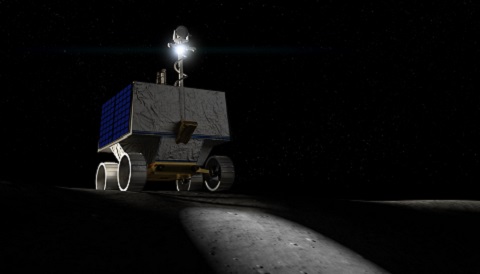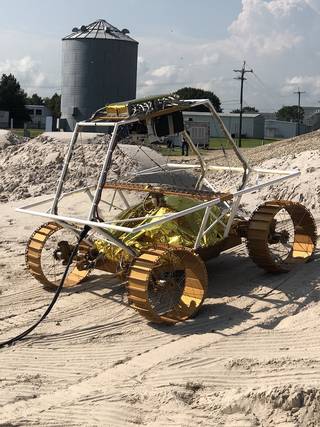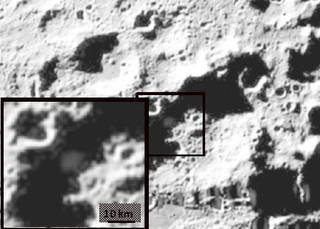A new NASA rover named VIPER will investigate the lunar south pole in preparation for the return of human explorers.

NASA Ames/Daniel Rutter
When it comes to space exploration, robotic explorers often precede humans. Last week, NASA announced a robotic mission, named the Volatiles Investigating Polar Exploration Rover (VIPER), will head to the lunar south pole to hunt for water ice and characterize the lunar soil. A four-wheeled rover about the size of a golf cart, VIPER will be built at the Johnson Space Flight Center. It is projected to cost $250 million dollars.
VIPER was preceded by the Resource Prospector mission concept. That was scrapped in 2018, but its instruments are being repurposed for other missions. VIPER is scheduled for a late 2022 landing, which would put it on the lunar surface before NASA’s ambitious "boots back on the Moon" goal for the Artemis program, currently set for late 2024. Data collected by the rover will help to construct global water resource maps of the lunar south pole.
VIPER is expected to last about 100 days, so the rover will forego nuclear power and operate strictly via solar panels and battery power. As such, it will eventually succumb to the cold lunar night.
As part of NASA’s new Lunar Discovery and Exploration Program, VIPER will involve partners across and outside of the agency. The launch vehicle and lander for VIPER will be contracted under NASA’s Commercial Lunar Payload Services program. “The specific details of the lander and the launch vehicle will be known after a competitive selection process,” says Alison Hawkes (NASA-Ames).

NASA/Johnson Spaceflight Center
VIPER will carry a suite of science instruments, including:
- The Neutron Spectrometer System, used to detect potential regions to drill, where water ice may exist.
- The Regolith and Ice Drill for Exploring New Terrain (TRIDENT), designed to drill into the lunar regolith down to a depth of one meter and return soil samples. Honeybee Robotics will design and build TRIDENT.
- The Mass Spectrometer Observing Lunar Operations (MSOLO) will analyze what TRIDENT digs up. The instrument will be designed at the Kennedy Space Center.
- The Near Infrared Volatiles Spectrometer System will also analyze the concentration and composition of the lunar soil samples. The Ames Research Center will develop this instrument.
Following the (Lunar) Water

NASA
Detected by the 2009 Lunar Crater Observation and Sensing Satellite (LCROSS) impactor mission and independently confirmed by India’s Chandrayaan 1 orbiter, as announced in a 2018 post-mission study, water ice is known to exist in the permanently shadowed craters near the lunar south pole and the South Pole-Aitken Basin region. Ancient asteroid and comet impacts probably delivered most of the water, and solar wind interaction with the lunar soil may also have played a role.
VIPER is designed to specifically prospect for water ice in these dark regions. If water ice exists in large quantities, future astronauts could conceivably exploit it not only for life support but also for fuel, by breaking it down into its hydrogen and oxygen component elements.
Capstone, Gateway & Artemis
Though NASA is well-versed in roving on Mars, this will actually be the first autonomous rover for NASA on the Moon, and the first soft-landing on the Moon for NASA since Apollo 17, the final Apollo mission in 1972. This also represents NASA’s first mission to the Moon’s polar regions—all of the Apollo missions landed at equatorial latitudes on the near lunar nearside.
However, other nations have been returning to lunar exploration in a big way. China made the first-ever landing on the lunar farside in January 2019 with Chang’e 4. The nation hopes to carry out an automated sample return in early 2020.
Israel and India also made lunar landing attempts this year, but those efforts failed. While India's Chandrayaan 2 lander didn't survive its crash landing, the orbiter remains operational. Also in lunar orbit are NASA’s Lunar Reconnaissance Orbiter and China’s Queqiao relay. Japan even plans to launch its Yaoki lander in 2021.
Ultimately, NASA plans to build and crew a Lunar Gateway as a planned staging point in lunar orbit for humans headed to the Moon’s surface. The Gateway is contingent on NASA’s new heavy lift rocket the SLS, now slated for an inaugural flight in 2021. Capstone, a pathfinder CubeSat lunar orbiter set to precede the Gateway, has been proposed for a December 2020 launch.
VIPER will operate independently of Capstone and the Gateway. “VIPER is designed to communicate 'Direct to Earth (DTE)' in order to not make its operations contingent on other missions,” says Hawkes.
The Moon — and especially the south lunar pole — will be a busy place soon enough. Hopefully VIPER will find vital resources to support extended human activity on the Moon.
 6
6









Comments
Robert-Casey
October 31, 2019 at 2:58 pm
Looks like this rover, with solar panels, will not be going to permanently shadowed lunar south pole craters. Where the frozen water likely is.
You must be logged in to post a comment.
Warren-Odom
November 4, 2019 at 12:32 am
Well, the article said it will also have batteries. It also said it would eventually succumb to darkness, so it must be going to visit shadowed areas at some point. Since it's supposed to last 100 days, the lunar night can't be the only darkness that affects it, since the night only lasts a bit under 15 days.
You must be logged in to post a comment.
astromaster
November 4, 2019 at 9:01 am
Here is your typical old astronomer having trouble with an article written by a younger writer. To say that NASA has had no Rovers on the Moon is just wrong! NASA, in the Apollo Program, put three Rovers on the Moon - Apollo 15, Apollo 16 and Apollo 17. Now, granted, they would be in the Used Rover Department in that they did require Humans to drive them. They may need some upgrades and have their batteries recharged, but I bet they would bring a steep price on the Used Rover Market! Just because they do not make them like that anymore does not open the way to claim NASA has not had Rovers on the Moon! Also, most of the early Programs did stay in the Equatorial Region due to fuel issues, but Surveyor 7 was sent to the edge of Tycho Crater which would rate as a bit south of center! Just my two cents worth!
You must be logged in to post a comment.
John Sheff
November 5, 2019 at 5:04 pm
That was my thought exactly when I came across that in the article. I had to read it again twice to make sure I hadn't missed something.
I hadn't.
You must be logged in to post a comment.
David DickinsonPost Author
November 5, 2019 at 5:18 pm
That is, NASA's first autonomous rover on the Moon... still a first.
You must be logged in to post a comment.
astromaster
November 4, 2019 at 9:12 am
One of the main good notes about this article is the responsible nature of NASA using the more risky Solar Power in exploring this region. As noted by earlier readers, this will limit the Rover's ability to fully search the dark regions that are so important. However, the Nuclear option opens this important region of the Moon to possible contamination for an area we have all identified as critical to our future exploration of the Solar System!
You must be logged in to post a comment.
You must be logged in to post a comment.